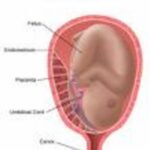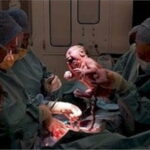Surviving a pregnancy is hard enough. Surviving a pregnancy with complications following a previous c-section is even harder.
While a c-section might seem routine, hidden dangers exist. I refer to these risks as “hidden dangers” because they are the things that physicians either gloss over or fail to inform patients of prior to the procedure. I was unfortunate enough to suffer from not one but two of such hidden dangers in my second pregnancy – placenta accreta and placenta previa.
Late in my first pregnancy, my doctor discovered that my baby was in the breech position. I was given two options: a scheduled c-section or a procedure called external cephalic version where the doctor manually tries to change the baby’s position. I chose a scheduled c-section because I was apprehensive about the potential risks of the version procedure to my baby. My doctor explained that even though I was having a c-section delivery, I may be able to have later vaginal births if all conditions were favorable.
When I became pregnant with my second child, I was determined to have a vaginal birth after cesarean (VBAC). However, at my 18-week ultrasound the technician discovered a problem. The ultrasound showed a condition called partial placenta previa. The placenta, or in my case part of the placenta, was covering the cervix. According to the Mayo Clinic, placenta previa can cause excessive bleeding before or during pregnancy. One of the risk factors for placenta previa is a previous c-section.
Although the 18-week ultrasound showed a partial placenta previa, I was unaware that I also suffered from a condition called placenta accreta. The American Pregnancy Association explains placenta accreta as “a condition that occurs when the placenta attaches itself too deeply to the wall of the uterus.” The condition occurs in only about 1 in every 2500 pregnancies. Instead of attaching to the surface of the uterine wall, the placenta actually begins to grow into the uterus itself. More serious forms of this placental abnormality include placenta increta or placenta percreta, which occurs when the placenta is no longer invading just the uterus but actually grows through the uterus and attaches itself to another organ, such as the bladder. Like placenta previa, one of the risk factors for placenta accreta is a previous c-section.
Giving birth vaginally with a partial placenta previa is dangerous and can lead to severe blood loss. In addition, an ultrasound at 28 weeks showed that although my placenta had moved into a low-lying position and was no longer covering the cervix, my baby was breech. Consequently, the doctor recommended a second c-section, and I agreed. In addition, I was put on pelvic rest, which means no intercourse for the duration of the pregnancy. The doctor also would not perform a pelvic examination during the pregnancy due to the risk of causing a hemorrhage.
The c-section itself began relatively uneventfully. Although the spinal anesthesia was difficult to place and had to be attempted several times before it was successful, the baby was delivered safely and had apgars of 9 and 9. It was not until the doctor was delivering the placenta that things began to go wrong. Instead of coming out in one piece, the placenta adhered to the uterine wall and tore in several places. I remember hearing one of the three doctors performing the surgery comment about a tear, but I did not realize at the time what was happening. I later learned that the doctor performing the surgery had to use a piece of gauze to scrape attached pieces of the placenta out of my uterus. As a result of the tearing, the doctor advised that there was a possibility of hemorrhage or infection.
An article in the American Family Physician reports that 30 percent of reported cases of placenta accreta occur in women with on previous cesarean. According to the American Pregnancy Association, multiple cesareans were present in over 60 percent of all cases of placenta accreta.
Treatment alternatives vary depending on the ability of the physician to control blood loss and avoid hemorrhage during and after delivery. The worst case scenario for placenta accreta included blood transfusions or hysterectomy and resulting loss of the ability to conceive.
Following the c-section, antibiotics were administered to me by I.V. to try to stave off any infection. I was watched closely for excessive bleeding or fever. In addition, the doctor warned me that retained pieces of the placenta may continue to be expelled from the uterus for up to 6 weeks following the c-section. For several weeks after the surgery, my uterus continued to expel small pieces of the retained placenta.
I was fortunate insofar as the placenta previa and placenta accreta did not cause serious consequences for me or for my baby during this pregnancy. Nevertheless, I have been advised that in future pregnancies it is possible that the placenta may grow even more deeply into my uterus or even become attached to other organs. The hidden danger of my original c-section may ultimately mean that I will not have any future pregnancies.
Sources:
American Pregnancy Association, “Placenta Accreta,” American Pregnancy Association Staff.
http://www.americanpregnancy.org/pregnancycomplications/placentaaccreta.html
American Family Physician, “Risk of Hemorrhage and Scarring in Placenta Accreta – Statistical Data Included,” Anne D. Walling, M.D.
http://findarticles.com/p/articles/mi_m3225/is_2_60/ai_55391939
Mayo Clinic, “Placenta Previa,” Mayo Clinic Staff.
http://www.mayoclinic.com/health/placenta-previa/DS00588



